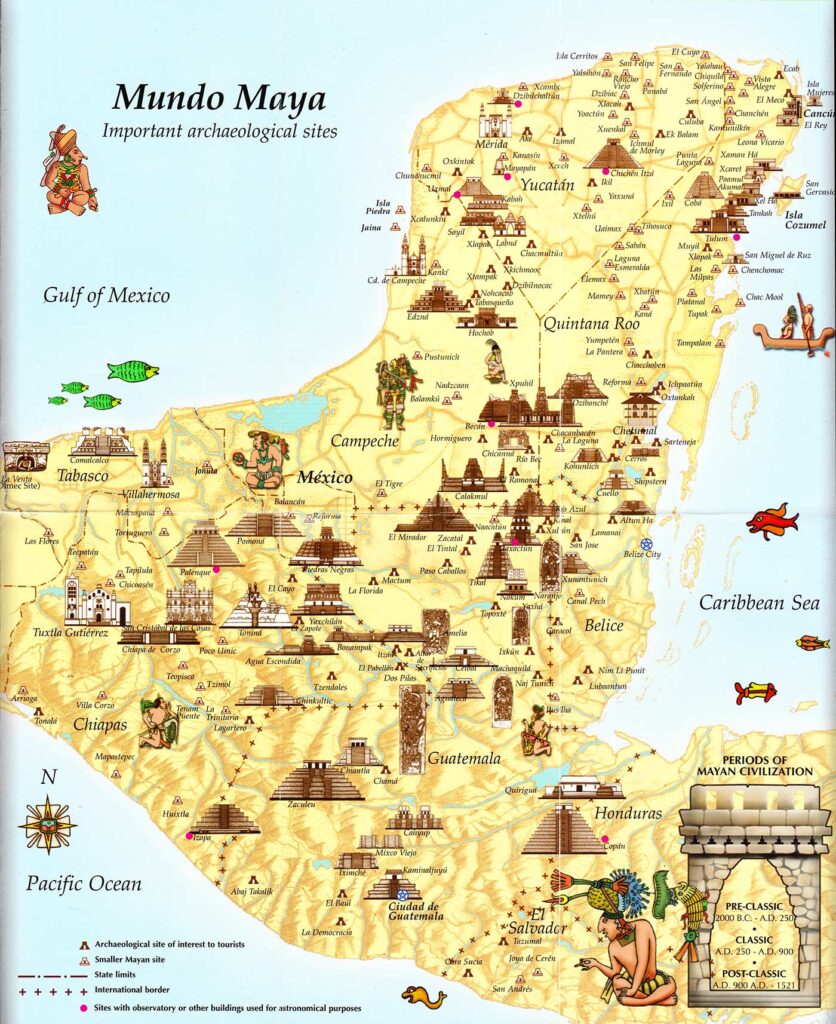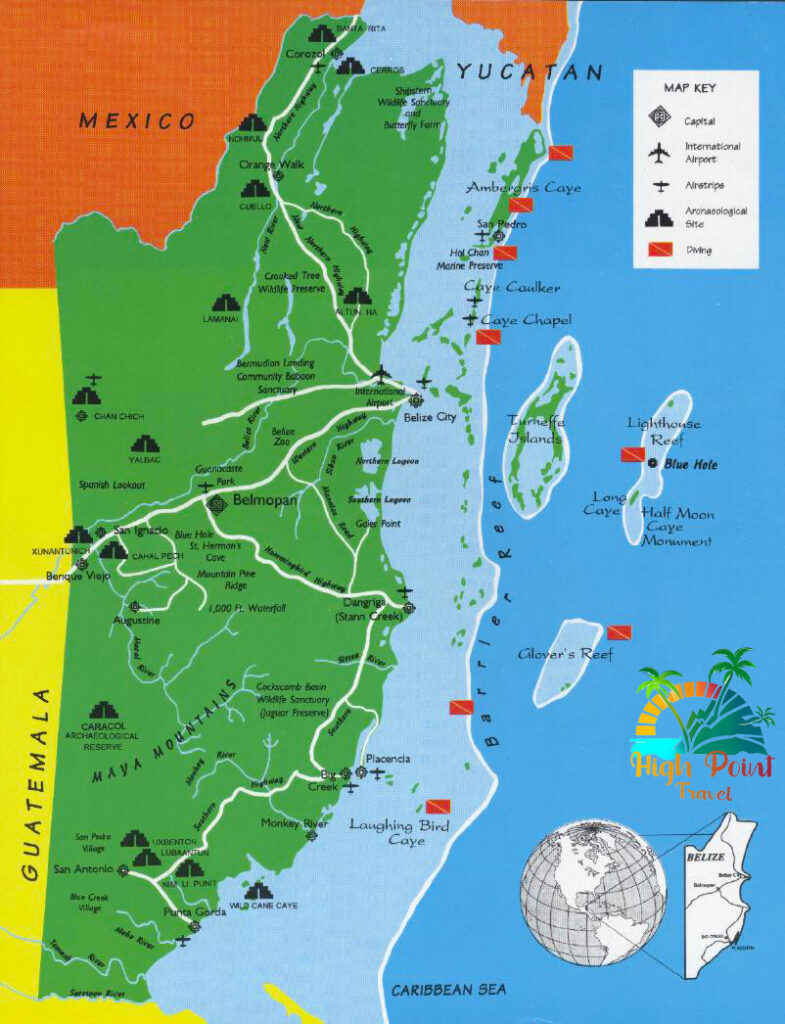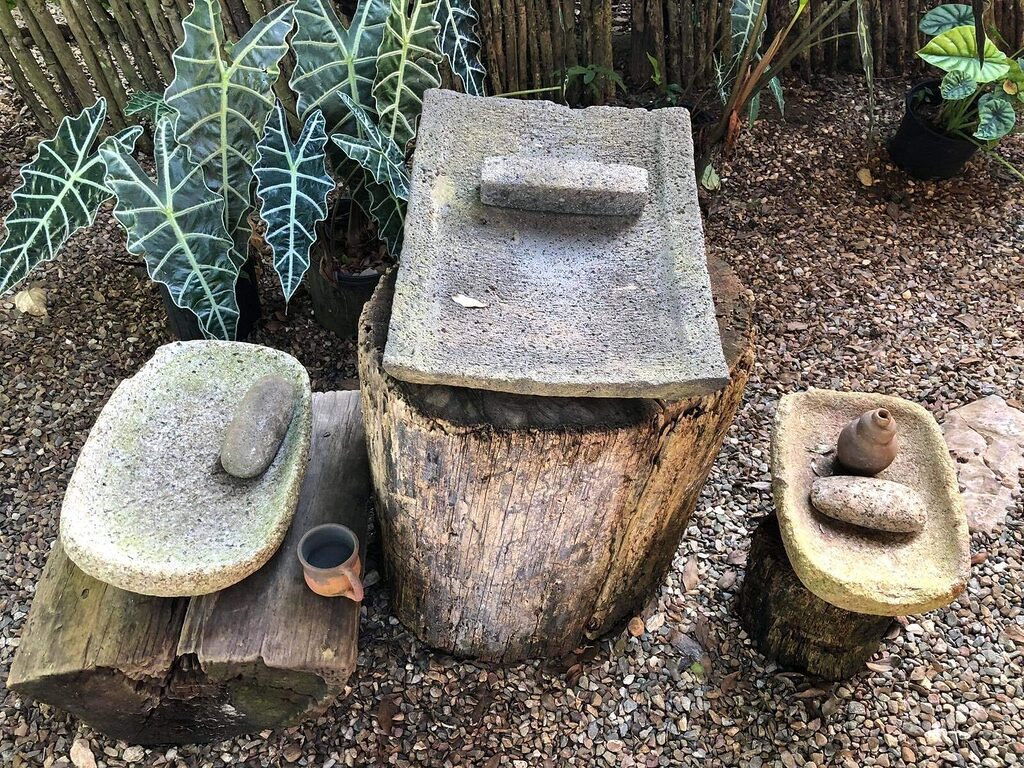Before the Ruins: The Maya Civilization That Shaped Belize
The story of Belize’s caves, temples, and ceremonial sites begins long before tourists ever set foot inside them. To understand the sacred places scattered across the country, you first need to know the civilization that created them: the Maya. Their presence still echoes in the landscape, the languages, and even in the way Belizeans today relate to nature, land, and ancestry.
A Landscape Once Ruled by the Maya
Archaeological evidence shows that the Maya civilization extended across what is now southern Mexico, Guatemala, western Honduras, El Salvador—and of course, Belize. While cities like Caracol and Xunantunich draw most of the attention, Maya life was widespread.

Maya Presence in Placencia
Long before it was a sleepy fishing village or a modern tourist haven, the Placencia Peninsula was home to Maya communities. Pottery shards, stone tools, and burial sites have been unearthed throughout the peninsula, particularly near Maya Beach and Riversdale. These finds suggest the area was used not just for living, but also for ceremonial or trade-related purposes, possibly linking inland cities with coastal exchange routes. Archaeologists have unearthed Early Classic salt works in the Paynes Creek–Placencia Lagoon region—showing Maya coastal communities were key nodes in trade networks.
Long Caye: The Outermost Reach
Further offshore, Long Caye at Lighthouse Reef Atoll reveals the remarkable extent of Maya travel and influence. Artifacts found here—including obsidian blades and marine shell beads—indicate the Maya journeyed to this atoll, over 50 miles from the mainland. This could have been for ritual purposes, seasonal harvesting, or spiritual observation, tying the sea into their cosmology. Palaeoecological data show ancient Maya land use on nearby Ambergris Caye—demonstrating their ability to settle and exploit island environments, supporting theories about Maya presence on Long Caye.

Personal Connections With Maya Culture
As someone of Creole ethnicity, I’ve had the privilege of growing up among and studying alongside Maya people throughout Belize. Many of my classmates and friends from southern villages like Red Bank were of Mopan, K’ekchi’, or Yucatec Maya descent. We grew up going to school together, and as adults, some of us became licensed tour guides together.
I’ve attended several Maya weddings, experienced traditional cooking firsthand, and developed close bonds that helped me understand their culture beyond books and ruins. One of my favorite fish dishes comes from a Maya friend’s family recipe. Because of these shared experiences, I often say with pride, “I dah tribe”—a popular expression in Belize today that acknowledges cultural kinship across communities.
Trade and the Oldest Maya Ruins in Belize
Trade played a crucial role in Maya civilization. Belize’s rivers and coastline connected inland cities with far-flung regions, allowing for the movement of jade, obsidian, cacao, textiles, and sacred items. The Maya traded extensively with neighboring Mesoamerican cultures.
Some of the oldest known Maya sites in Belize include Cahal Pech, which dates back to as early as 1200 BCE. Its hilltop location likely served as both a defensive post and a ceremonial center. Other ancient sites like Cuello in Orange Walk also show evidence of early Maya development, including plastered buildings and ceremonial platforms from the Preclassic period.
Learn more about the Maya timeline or Calendar
Where the Maya Ruins Are Located in Belize
Belize’s Maya ruins are spread across nearly every district:
- Cayo District: Caracol, Xunantunich, Cahal Pech, El Pilar
- Toledo District: Lubaantun, Nim Li Punit
- Orange Walk District: Lamanai, Cuello
- Belize District: Altun Ha
- Corozal District: Cerros, Santa Rita
Each ruin is situated in areas where trade routes, access to water, fertile land, or sacred natural features like caves played a key role in its placement.

Sacred Causeways and Maya Society
In some Maya cities like Caracol, archaeologists have uncovered sacbeob—ancient elevated limestone causeways that connected major city-states with smaller settlements. These pathways were likely used by traders, messengers, pilgrims, and possibly even military personnel. Their presence reveals the complexity of Maya infrastructure and how deeply interconnected various city-states were.
The Sacred Worldview
To the ancient Maya, caves were portals to Xibalba, the underworld. Mountains were sacred. The sea had gods of its own. Every feature of the landscape had spiritual significance, and the people who lived here designed their settlements and rituals accordingly.
Maya Ruins and Their Associated Caves (Theoretical Connections)
| Maya City-State | Location (District) | Notable Nearby Cave | Possible Connection |
|---|---|---|---|
| Caracol | Cayo | Rio Frio Cave, Mountain Cow Cave | Likely used for elite rituals and astronomical rites |
| Xunantunich | Cayo | Actun Tunichil Muknal (ATM) | Shared regional use; high-value offerings |
| Cahal Pech | Cayo | Actun Chapat / Actun Halal | Possibly ritual access for nearby nobles |
| Lubaantun | Toledo | Hokeb Ha Cave | Regional pilgrimage and water source significance |
| Nim Li Punit | Toledo | Yok Balum Cave | Spiritual ceremonies linked to agricultural cycles |
| Altun Ha | Belize | No known major cave nearby | Likely relied on ceremonial mounds and pyramids |
| Lamanai | Orange Walk | Indian Church caves (unverified) | Could be minor local use or ceremonial transport |
| El Pilar | Cayo | El Pilar Cave System (unmapped) | Understudied but expected based on settlement scale |
Rainforest Wisdom and Biodiversity
The ancient Maya were deeply connected to the rainforest. Belize’s tropical forests offered a rich bounty of plants and animals that supported everyday life—but they also served as pharmacies. The Maya had extensive knowledge of plant-based medicine.
This tradition of using forest remedies continued well into modern times. One of the most famous herbalists in Belize, Elijio Panti, was a traditional healer who used Maya techniques and rainforest plants to treat illness. His legacy lives on in the teachings passed to younger generations and in the preservation of medicinal plant knowledge.
Today, the lush rainforests around sites like Elijio Panti National Park not only attract hikers and birders—they remain living examples of how the land once sustained a civilization.

Legacy and Living Culture
Today, Belize is home to modern Maya communities—Mopan, Q’eqchi’, and Yucatec Maya—who maintain elements of traditional knowledge, farming, food, and language. These communities are concentrated in southern Belize but can be found across the country. Their resilience helps keep Maya heritage a living force, not just an artifact.
One example of a modern Maya cultural experience is the San Antonio Women’s Cooperative in the Cayo District. Here, visitors can learn about traditional Mopan Maya cooking, farming, and pottery from women who continue to pass down ancestral practices. It’s a hands-on way to connect with the living culture behind the ruins.
In the south, the Maya Deer Dance is becoming popular with locals and foreigners alike. When I first saw them, I was a bit mesmerized by the costumes because we had heard about it but never saw it. The Deer Dance is a ceremonial performance that tells a story of balance between the human and natural world, representing hunting traditions, spiritual beliefs, and respect for the forest.

Environmental and Cultural Threats Today
Many Maya sites in Belize remain vulnerable to threats such as illegal looting, encroaching agriculture, climate change, and infrastructure development. Conservation efforts led by the Belize Institute of Archaeology and international partners help protect these priceless legacies. Awareness and respectful tourism play a vital role in preservation.
How the Maya Differ from Other Mesoamerican Civilizations
Frequently Asked Questions About the Maya Civilization in Belize
Yes. Belize has thriving Maya communities, especially in southern districts like Toledo. Many modern Maya people still speak native languages and practice traditions passed down for generations.
I talk to Mopan Maya people, K’ekchi’ and Yucatec Maya. Some are my friends who took the tour guide class with me. I also went to school with them growing up in the south before moving west. I’ve been to a few Maya weddings as well—so yes, they are still very much around. One of my favorite fish dishes is from the Maya culture.
Yes. Archaeological evidence confirms Maya settlements on the Placencia Peninsula and at Long Caye. These sites were likely used for trade, ceremonial activities, or seasonal harvesting
Cahal Pech is among the oldest, dating back to 1200 BCE. Cuello in the north also features some of the earliest known plastered buildings.
They used them as portals to the underworld, for rituals, offerings, and ceremonies. Many of these caves still contain artifacts today.
The Maya had independent city-states, developed a hieroglyphic writing system, and were more spiritually connected to natural features like caves.
Yes. Places like the San Antonio Women’s Cooperative let you experience modern Maya food, pottery, and traditional farming techniques.
In many cases, yes. Some caves near Maya cities served ceremonial or spiritual purposes. These relationships are still being studied.
It shapes Belize’s national identity and promotes conservation, education, and cultural pride across the country.
Sources & Further Reading
- Awe, J. J. (2001). The Rise and Decline of Caracol, Belize. Belize Institute of Archaeology.
- McKillop, H. (2005). In Search of Maya Sea Traders. Texas A&M University Press.
- National Geographic (2010). Maya Salt Works Discovered in Belize
- Garber, J. F. (2004). The Ancient Maya of the Belize Valley: Half a Century of Archaeological Research. University Press of Florida.
- Belize Institute of Archaeology – www.nichbelize.org
- Journal of Caribbean Archaeology – www.flaarchaeology.org/journal/
- San Antonio Women’s Cooperative, Cayo – Local visit and community insights
